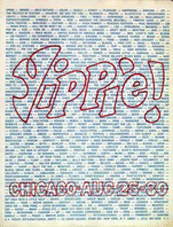THE YIPPIES
The 1960s were marked by both cultural and political revolution. Culturally, the hippies brought about many changes with their "love and peace" philosophy, liberal behavior, as well as their unconventional looks. However, many of those who welcomed the hippie lifestyle were not eager about confronting the system directly.
On a political level, some social groups were becoming more and more aware of the burning issues of racism, women's rights and the Vietnam War. Some of those groups were quite ready to use force and the power of masses to achieve political goals.
The Yippies (Youth International Party) were in between – they merged together the political and the cultural side of the revolution.
The name and the flag
Abbie Hoffman and his wife Anita Hoffman, Jerry Rubin, Nancy Kurshan, and Paul Krassner founded the Yippies. The organization had no formal hierarchy and the very term Yippie was made up by Krassner on New Year's Eve 1967., while Anita Hoffman came up with 'Youth International Party', because it symbolized the movement.
 A Yippie flag was designed, presumably by Abbie Hoffman, and was frequently seen at anti-war demonstrations. The flag had a black background, a five pointed red star in the center, with a green cannabis leaf over it. A Yippie flag was designed, presumably by Abbie Hoffman, and was frequently seen at anti-war demonstrations. The flag had a black background, a five pointed red star in the center, with a green cannabis leaf over it.
The activism
Although the Yippies were more radical than the hippies, most members and associates drew the line at organized protests and sit-ins. They were notorious for suggesting outlandish acts of sabotage or civil disobedience, but rarely carried out these extreme plans. Their typical suggestions were placing LSD in a city's water supply or having a circle of Yippies levitate the Pentagon.
They threw dollar bills and laughed as millionaire stockbrokers scrambled after the money, put soot bombs to warn about pollution, and mailed 3,000 marijuana joints to random strangers from the phone book. Their energy and creativity brought them much publicity, thus during the Democratic National Convention, they gained media attention by nominating a pig named Pigasus for president.
By 1968, one of the issues which affected all counterculturalists was the continuation and escalation of the Vietnam War. When the Democratic party announced plans to hold its national convention in Chicago, key leaders of these various factions urged members to hold rallies outside of the facility.
 In an attempt to present a united front against the current political regime, the Yippies planned to hold a "Festival of Life" in the park outside of the Democratic National Convention, along with the leaders of other counterculture groups, including the militant SDS and the National Mobilization Committee (MOBE). The mayor of Chicago, Richard Daley, also called for increased security forces, riot police and the National Guard. In an attempt to present a united front against the current political regime, the Yippies planned to hold a "Festival of Life" in the park outside of the Democratic National Convention, along with the leaders of other counterculture groups, including the militant SDS and the National Mobilization Committee (MOBE). The mayor of Chicago, Richard Daley, also called for increased security forces, riot police and the National Guard.
Protesters and law enforcement officers clashed violently. A number of Yippies were injured or arrested, including Abbie Hoffman and Jerry Rubin.
The trial of the Chicago Seven
Months after the convention, Hoffman, Rubin and six other protest leaders were charged with violating a recently enacted federal Anti-Riot Act. The legal proceedings became known as the trial of the Chicago Seven: Abbie Hoffman, Jerry Rubin, David Dellinger, Tom Hayden, John Froines, Rennie Davis and Lee Weiner.
The trial became a media circus, with some of the defendants arriving in judges' robes over a cop's uniform to symbolise that the capitalist judicial system was about punishment and political repression rather than justice. On the other hand, judge Hoffman's questionable pre-trial decisions hindered the efforts of defense attorneys William Kunstler and Leonard Weinglass.
Despite the theatrics and occasionally heavy-handed tactics used by both sides during the trial, John Froines and Lee Weiner were found not guilty of the charges. The other five members of the Chicago Seven were found guilty of violating the Anti-Riot Act of 1968 and were given various sentences.
Judge Hoffman sentenced all of the Chicago Seven and their attorneys to several years in prison for a number of contempt of court citations. Following the Appeals Court decision to overturn their original sentences, members of the Chicago Seven resumed their lives during the 1970s.
What followed…
The Yippies became increasingly fragmented throughout the 1970s, although several underground magazines published in New York City managed to keep the Yippies' storied past alive. A new generation of Yippies still maintains a presence on Bleecker Street, but their impact on American politics has been muted in recent years.
|

